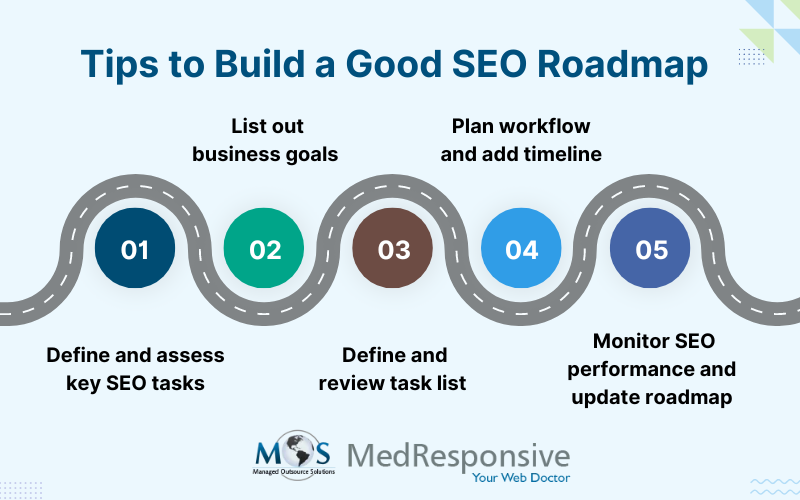What’s an SEO Roadmap?
An SEO roadmap is a collective document used by a search engine optimization company that outlines broad strategic SEO tasks, key opportunities and a step-by-step plan of action. This will help to more quickly achieve the goal of improving a website’s search engine performance. It is created at the beginning stage of an SEO campaign to provide an overview of detailed tactics, assigned individuals and target deadlines over a period of six to twelve months. SEO strategies are not set in stone, as amendments or changes can be made at any time of the project in accordance with the relevant trends and market changes in SEO. Due to this volatile nature, an SEO roadmap is also known as a”living” document.
What are the Benefits of SEO Roadmaps?
Like any strategy, an SEO roadmap benefits businesses in their campaigns. You can tailor the roadmap to meet your unique set of business priorities. The roadmap paves the way for stakeholders, clients and other team members to reach an understanding and agreement on the tasks that lie ahead for effective collaboration. With a solid plan, you can keep SEO marketing in track, measure activity results and achieve maximum ROI. Now let’s look at some stellar benefits of using a good SEO roadmap:
- Align SEO efforts with business goals
An SEO roadmap is a strategic blueprint that aligns your team to the right business objectives. Your digital marketing team creates and employs it to boost your company’s search engine ranking. It also plots the course of your business’ success and if leveraged correctly, ensures that your marketing efforts bear fruit.
- Getting collaborators on the same page
SEO roadmap is the collaboration point of SEO specialists, content creators, web developers, and the marketing and engineering of the product. They all must work together and centralize to achieve a successful SEO campaign. It also acts as a central document that clearly outlines and defines the roles of each department and assigns specific tasks to the responsible team, thereby streamlining the internal communication across all branches.
- Prioritize SEO efforts with business goals
To receive the desired outcome, you must match the SEO strategy with the final business objectives. Using a roadmap helps you prioritize the initiatives that yield the highest results within the time limit for the intended business goals. For example, if your client’s purpose is to increase organic website traffic and drive sales, then implementing steps such as using the right keywords, producing high-quality, reliable blog content on a timely basis, conducting site audit and analyzing organic traffic results through platforms like Google Analytics helps accomplish the goals.
- Optimize SEO for maximum ROI
When you diligently lay out all the task details, it is easier to structure and divide the process into smaller, manageable tasks that allows you to capitalize on quick wins. Quick wins are a great way to implement minimal development tasks on content that already exists such as updating Meta description or fixing broken links. The advantage of quick wins is that you can see that minor changes generate some traction for your website right away and improve your ranking within a couple of weeks or months. In this way you can anticipate outcomes in advance and adjust larger projects accordingly to ensure optimized SEO.
How to Build a Good SEO Roadmap
To construct an effective SEO roadmap, you should have an understanding of the following preliminary and ongoing multiple stages involved. Here are some tips on how to build an SEO roadmap:
- Define and assess key SEO tasks
Clearly define your SEO tasks by assessing your current standing. An overall viewpoint of the project’s status will provide your insight regarding which action items are to be completed on the basis of impact, time and priority. Each roadmap will differ according to the unique factors present in a project. Conduct a comprehensive audit of your website to identify the strengths, weaknesses, errors, first priority actions and opportunities for areas of improvement.
- Audit and analyze the website traffic
- Conduct keyword research
- Check for and fix any broken links
- Create new website content and delete duplicate ones
- Optimize Metadata such as Meta title and Meta description with relevant keywords
- Implement schema markup
- Include visual aspects like images and videos for retaining visitors
- Review and regularly update website content
- Monitor SEO trends and adjust strategies accordingly
- Investigate website speed rate, security and user experience
- Build high-quality back links from authority news sites and blogs
- Conduct a competitive analysis
SEO consulting services employ software that automates the SEO audits to present a concise, detailed and understandable report for the client. It’s then possible to set SMART (specific, measurable, achievable, relevant, and time-bound) goals for the action steps to keep you on track.
- List out your business goals
The primary actions included in the SEO analysis should align with the client’s business goals. Not all SEO strategies are needed for all projects, so it is important that you consider only those that are beneficial for the company’s objectives. Effective utilization of resources saves time, effort and money so write out the list of overarching tasks to be implemented in accordance with the business goals.
For example, if you are working for an e-commerce business client then your focus is on improving online sales. This is done by optimizing the product website to generate organic traffic growth, gain new customers through online exposure and generate more revenue. So, the main goal here is to drive organic growth for the company and hence, implement SEO strategies that pertain to this goal.
- Define and review tasks list
The next integral step is to define and create the entire to-do list to be attained at the end of the SEO campaign based on goals listed. You can create an action priority matrix, also known as Eisenhower matrix, which is a task management tool to organize workflow based on urgency and importance. The tool divides tasks as:
- Quick wins
- Major projects
- Fill-ins
- Thankless tasks
Refining your larger list to focus on tasks mentioned above provides a framework to make informed decisions, streamline workload and maximize productivity. For example, if the task is to update the website to rank higher in the search engine results page for a geographical location, you can break it down into smaller chunks as follows:
- Conduct in-depth research about the specific geographical locations that you target and extract traffic by various criteria to understand the local culture, cultural nuances and the preferred languages of this region.
- Assign the data to the SEO team to analyze, identify and strategize the actions to take
- Translate all the website content including text, images and other visual medias into the required languages
- Include region-specific keywords, meta tags and language-specific URL, hreflang tags and CDNs
- Launch localized versions of your website
- Analyze the traffic from specific regions and evaluate their performance
The above tasks involve contribution from various departments such as SEO specialists, content writers and creators, technical development and support teams.
- Plan workflow and add timeline
The next step is to plan out the workflow to assign tasks to the responsible team members. While planning out the tasks, it is equally important to understand and identify the resources available to allocate for each project. Assess the required resources needed for each department by:
- In-house staff time
- External agencies (such as outsourced digital marketing services)
- Tools available
Allocate your resources according to the highest priority in the task list and have realistic expectations about what you can achieve with the available resources. The success of an SEO campaign lies in attaining the maximum possible outcome and ROI within the given budget of a project. Create a SEO roadmap that details instructions and outlines the workflow for your staff to follow so they can complete the work on time.
After you’ve set the workflow and resources, SEO roadmap should feature a timeline to give a rough idea of how long each of the action items should take to complete. Depending upon the duration and goals of each project, the timeline can vary from 6 months to more than a full calendar year. Within this timeline, divide the tasks into phases consisting of goals to be tracked and check the progress. This establishes a seamless workflow that eases the workload burden, reduces chances of mistakes and gives your team a pre-planned schedule to follow.
To add timeline for the SEO roadmap, you should:
- Enter the number of days or weeks allocated for each task in the respective month column
- Maintain a half-day or full day interval
- Consult the team leaders or members for approving the time given
- Format and arrange your time estimates to flow in a Gantt chart-style
- Monitor your performance and update the roadmap
With SEO roadmap, it’s easy to get distracted by the planning side of things, but you shouldn’t forget to continuously monitor and measure your website SEO performance in the search results. The element of a successful SEO strategy lies in ongoing analysis to keep the roadmap agile and relevant. Add a section to regularly track and update the status of each measurement metric of SEO. You should employ tools such as Google Analytics to measure the SEO KPI metric:
- Direct traffic
- Organic traffic
- Paid search traffic
- Search visibility
- Conversion rate
- Keyword ranking
- SERP features
- Bounce rate and engagement rate
- Scroll depth
- SEO site health
- Competitor analysis
- Website speed and security
- Backlink profile
Monitoring these above metrics is important to gauge the effectiveness of your efforts and help stakeholders understand whether your SEO campaign yields the desired outcome. If the results aren’t what you expected, then you should identify which part of the SEO strategy fell off. So, regular revision and updating the strategy is important for continuous improvement. Remain flexible and adjust wherever necessary, such as assigning the role of leader from one team member to another, or removing a team member if they’re not suitable for the given task. Conduct scheduled meetings with staffs to discuss goals, room for improvements, setbacks and individual opinions. Finally, appreciate and recognize positive work to motivate your team and reinforce a collaborative mindset.
Final thoughts
Crafting a fully defined SEO roadmap can be a game-changer for any organization, if leveraged effectively. Aligning the goals, resources and strategies of SEO for the respective business will unearth opportunities to reach the intended end result and impact your success. It takes effort to track each project from start to end, so create the roadmap with a simple spreadsheet detailing the entire SEO strategy to make it accessible and easy to understand. Keep the guidelines outlined above in mind while developing your roadmap and achieve your most challenging SEO goals with ease.
You are on the path to SEO success when working with our experienced SEO specialists!





